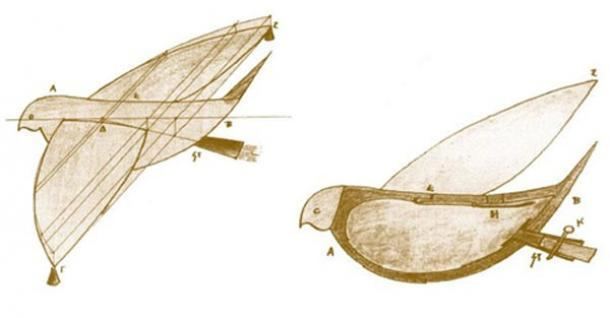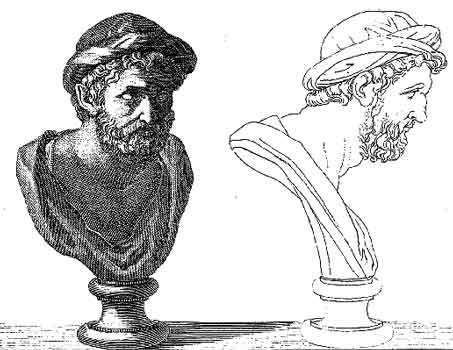Name Archytas Archytas Notable ideas Archytas curve | Died 347 BC Role Philosopher Region Western philosophy | |
 | ||
Similar People Pythagoras, Anaximander, Iamblichus, Empedocles, Parmenides | ||
Archytas of tarentum salvator rosa dulwich picture gallery
Archytas (; Greek: Ἀρχύτας; 428–347 BC) was an Ancient Greek philosopher, mathematician, astronomer, statesman, and strategist. He was a scientist of the Pythagorean school and famous for being the reputed founder of mathematical mechanics, as well as a good friend of Plato.
Contents

Life and work

Archytas was born in Tarentum, Magna Graecia and was the son of Mnesagoras or Histiaeus. For a while, he was taught by Philolaus, and was a teacher of mathematics to Eudoxus of Cnidus. Archytas and Eudoxus' student was Menaechmus. As a Pythagorean, Archytas believed that only arithmetic, not geometry, could provide a basis for satisfactory proofs.

Archytas is believed to be the founder of mathematical mechanics. As only described in the writings of Aulus Gellius five centuries after him, he was reputed to have designed and built the first artificial, self-propelled flying device, a bird-shaped model propelled by a jet of what was probably steam, said to have actually flown some 200 meters. This machine, which its inventor called The pigeon, may have been suspended on a wire or pivot for its flight. Archytas also wrote some lost works, as he was included by Vitruvius in the list of the twelve authors of works of mechanics. Thomas Winter has suggested that the pseudo-Aristotelian Mechanical Problems is an important mechanical work by Archytas, not lost after all, but misattributed.

Archytas named the harmonic mean, important much later in projective geometry and number theory, though he did not invent it. According to Eutocius, Archytas solved the problem of doubling the cube in his manner with a geometric construction. Hippocrates of Chios before, reduced this problem to finding mean proportionals. Archytas' theory of proportions is treated in book VIII of Euclid's Elements, where is the construction for two proportional means, equivalent to the extraction of the cube root. According to Diogenes Laertius, this demonstration, which uses lines generated by moving figures to construct the two proportionals between magnitudes, was the first in which geometry was studied with concepts of mechanics. The Archytas curve, which he used in his solution of the doubling the cube problem, is named after him.

Politically and militarily, Archytas appears to have been the dominant figure in Tarentum in his generation, somewhat comparable to Pericles in Athens a half-century earlier. The Tarentines elected him strategos, 'general', seven years in a row – a step that required them to violate their own rule against successive appointments. He was allegedly undefeated as a general, in Tarentine campaigns against their southern Italian neighbors. The Seventh Letter of Plato asserts that Archytas attempted to rescue Plato during his difficulties with Dionysius II of Syracuse. In his public career, Archytas had a reputation for virtue as well as efficacy. Some scholars have argued that Archytas may have served as one model for Plato's philosopher king, and that he influenced Plato's political philosophy as expressed in The Republic and other works (i.e., how does a society obtain good rulers like Archytas, instead of bad ones like Dionysius II?).
Archytas may have drowned in a shipwreck in the shore of Mattinata, where his body lay unburied on the shore until a sailor humanely cast a handful of sand on it. Otherwise, he would have had to wander on this side of the Styx for a hundred years, such the virtue of a little dust, munera pulveris, as Horace calls it in Ode 1.28 on which this information on his death is based. The poem, however, is difficult to interpret and it is not certain that the shipwrecked and Archytas are in fact the same person.
The crater Archytas on the Moon is named in his honour.
Archytas curve
The Archytas curve is created by placing a semicircle (with a diameter of d) on the diameter of one of the two circles of a cylinder (which also has a diameter of d) such that the plane of the semicircle is at right angles to the plane of the circle and then rotating the semicircle about one of its ends in the plane of the cylinder's diameter. This rotation will cut out a portion of the cylinder forming the Archytas curve.
Another way of thinking of this construction is that the Archytas curve is basically the result of cutting out a torus formed by rotating a hemisphere of diameter d out of a cylinder also of diameter d. A cone can go through the same procedures also producing the Archytas curve. Archytas used his curve to determine the construction of a cube with a volume of one third of that of a given cube.
